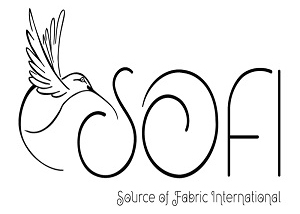If you’re in the market for fabric, you know that quality and cost can often feel like a balancing act. Discount wholesale fabric offers a fantastic solution, allowing you to access a wide variety of materials without breaking the bank. Whether you’re a seasoned designer, a small business owner, or a DIY enthusiast, finding affordable fabric can elevate your projects while keeping your budget intact.
Imagine the possibilities when you discover a treasure trove of discounted fabrics. From vibrant prints to luxurious textures, wholesale options provide you with the freedom to explore your creativity. Plus, buying in bulk means you can stock up on your favorites, ensuring you always have the right material on hand for your next big idea. Dive into the world of discount wholesale fabric and unlock the potential for stunning creations at unbeatable prices.
Understanding Discount Wholesale Fabric
Discount wholesale fabric refers to bulk fabric available at reduced prices, providing an affordable option for various buyers. This type of fabric often features a wide range of materials, colors, and patterns.
What Is Wholesale Fabric?
Wholesale fabric involves purchasing fabric in large quantities directly from manufacturers or suppliers. Retailers sell fabric at wholesale prices, offering bulk buyers significant savings compared to typical retail costs. The sizes can vary, including bolts or rolls, allowing for flexibility in purchasing based on project needs. Fabrics can include cotton, polyester, linen, and blends, catering to different markets such as apparel, home décor, and crafts. By obtaining fabrics in larger amounts, you access better rates and a diverse selection for your creations.
Benefits of Buying Discount Wholesale Fabric
Buying discount wholesale fabric provides several advantages. Cost savings serves as the primary benefit, where purchasing in bulk leads to lower prices per yard. Variety plays a crucial role, allowing access to different textures and designs, which enhances creativity. Quality remains important; many discount wholesale fabrics maintain high standards, enabling you to create stunning projects without compromising quality.
Consistent supply reduces the worry of running out of fabric mid-project. This reliability becomes vital for businesses requiring a steady inventory. Opportunities for small business owners and designers arise as this option allows for creating unique offerings at competitive prices. Overall, using discount wholesale fabric opens the door for innovative projects while remaining budget-friendly.
Finding Discount Wholesale Fabric Suppliers
Finding reliable suppliers for discount wholesale fabric involves exploring various sources, both online and local. Accessing these options ensures you can purchase materials that fit your creative projects and business needs while maximizing savings.
Online Suppliers
Online suppliers offer extensive selections, competitive prices, and the convenience of shopping from any location. Utilize search engines to locate wholesale fabric websites that specialize in discounted products. Consider popular platforms such as:
- Fabric.com: Browse a wide array of fabrics, including cotton, silk, and upholstery. Regular sales and discounts are available.
- Etsy: Discover many fabric sellers offering discounted prices on unique materials. Reading seller reviews assists in finding trustworthy vendors.
- Wholesale Fabric Direct: Explore a large selection of fabrics specifically for bulk purchases, often featuring clearance sections for added savings.
Compare prices and review customer feedback to ensure quality. Utilize social media platforms to connect with fabric suppliers and join groups focused on fabric sourcing. Signing up for newsletters grants access to exclusive deals and promotions.
Local Suppliers
Local suppliers can provide a hands-on experience and immediate access to fabrics. Visit nearby fabric stores and ask about bulk purchasing options or discounts for larger orders. Look for:
- Independent Fabric Stores: Engage with local businesses that might offer discounts to loyal customers or for bulk purchases.
- Textile Mills: Research local textile mills for direct purchasing opportunities, which can yield significant cost savings.
- Flea Markets: Explore local flea markets that often feature vendors selling fabrics at reduced prices.
Building relationships with suppliers fosters trust and can lead to additional savings or exclusive access to new inventory. Regular visits to local suppliers can uncover unique fabrics and materials not available online.
Trade Shows and Fabric Fairs
Trade shows and fabric fairs serve as excellent platforms to find discount wholesale fabric suppliers. Attending these events allows for direct interaction with manufacturers, suppliers, and other industry professionals. Key points to consider include:
- Networking Opportunities: Connect with various fabric suppliers in one location. Networking can lead to direct purchasing arrangements for better pricing.
- Sample Fabrics: Obtain samples from suppliers to assess the quality before making larger purchases.
- Bulk Purchase Discounts: Many suppliers offer special pricing for orders placed during these events, making it possible to stock up on fabrics at lower prices.
Check industry websites and local event listings to learn about upcoming trade shows and fabric fairs. Attending multiple events allows you to see a variety of suppliers and materials, helping you make informed decisions about your fabric sourcing.
Evaluating Quality of Discount Wholesale Fabric
Evaluating the quality of discount wholesale fabric ensures you make the best choices for your projects. Focus on specific factors such as fabric types and their uses, along with effective tips for assessing quality.
Fabric Types and Their Uses
Different fabric types serve unique purposes. Below are common fabric types and their applications.
- Cotton: Versatile and breathable, cotton is suitable for clothing and home decor.
- Polyester: Strong and durable, polyester works well for outdoor items and activewear.
- Silk: Luxurious and smooth, silk is excellent for formal wear and accessories.
- Linen: Lightweight and absorbent, linen is ideal for summer clothing and table linens.
- Wool: Warm and insulating, wool is perfect for outerwear and winter garments.
Understanding these distinctions helps you select the right fabric based on your specific needs. When choosing wholesale options, consider the intended use along with fabric durability and appearance.
Tips for Assessing Fabric Quality
Assessing fabric quality involves several practical steps. Follow these tips to ensure the fabric meets your standards.
- Check Weight: Heavier fabrics typically indicate better durability. Look for a balance that meets your needs.
- Examine Weave: Inspect the weave for uniformity. Tight weaves often signal quality while loose weaves may lead to durability issues.
- Feel the Texture: Run your hand over the fabric. A soft texture usually enhances the overall appeal and comfort.
- Test Stretch: Gently stretch the fabric. Sturdy fabrics maintain their shape, while low-quality ones may distort easily.
- Look for Transparency: Hold the fabric up to the light. A quality fabric should maintain opacity, while overly sheer fabrics may indicate poor construction.
By applying these assessment tips, you secure quality materials that support your creative endeavors.
Budgeting for Discount Wholesale Fabric
Budgeting for discount wholesale fabric requires clear planning and understanding of costs. Set a budget that aligns with your project goals and financial constraints to facilitate smart purchasing.
Setting a Budget
Setting a budget for discount wholesale fabric involves identifying your total spending limit and considering various factors. First, determine how much you can reasonably spend on fabric. Second, include additional costs such as shipping fees and taxes in your overall budget. Third, factor in any potential costs for additional tools or materials needed for your projects. For example, if your spending limit is $500, ensure that $450 goes towards fabric, allowing $50 for shipping and other expenses. Fourth, prioritize which fabrics and quantities matter most to you to avoid unnecessary purchases. Lastly, keep some flexibility in your budget for unexpected costs, like price increases or additional supplies that may enhance your projects. Regularly revisiting and adjusting your budget can lead to more successful and satisfying purchases.
Calculating Fabric Yardage Needed
Calculating fabric yardage needed requires precise measurements and planning. First, identify the project you will undertake, such as a dress or upholstery. Second, check the pattern guide or instructions for the exact yardage requirement. Third, measure your project’s dimensions if creating something unique. Take measurements like chest, waist, and length for clothing, or width and height for home decor. Fourth, add at least 10-15% extra to account for errors, shrinkage, or pattern matching. For example, if your project calls for 3 yards, purchasing 3.3 to 3.5 yards provides a buffer. Fifth, consider fabric width; fabrics typically come in 44-45 inches or 54-60 inches. Wider fabrics can reduce the yardage needed. Lastly, consult with suppliers or check online calculators to ensure accurate calculations, supporting effective budgeting.
Purchasing Discount Wholesale Fabric
Purchasing discount wholesale fabric involves strategic planning and informed decision-making. Follow these key steps to ensure a successful procurement process.
Placing an Order
Placing an order for discount wholesale fabric begins with selecting the right supplier. Choose suppliers known for quality products and reliable service. Review their online catalogs for available fabrics, noting key details such as fiber content, weight, and patterns. Contact suppliers to clarify any questions before finalizing your choice.
Specify your order details clearly. State fabric type, quantity, and any specific colors or patterns needed. Providing accurate measurements ensures better alignment with your project requirements. After confirming these details, initiate the order. Review confirmation emails for accuracy, double-checking shipping information and estimated delivery times.
Consider using a purchase order if buying from a local wholesaler. A purchase order outlines the terms of the transaction and serves as a record. Ensure you keep documentation of your order for future reference.
Understanding Bulk Purchase Discounts
Understanding bulk purchase discounts is essential for maximizing savings when buying discount wholesale fabric. Many suppliers offer tiered pricing structures. These often provide significant price reductions as the quantity of fabric purchased increases.
Always compare prices across different suppliers. Reviewing multiple options allows you to identify the best deal while considering shipping costs and any potential fees. Most suppliers have minimum order requirements, which means buying in bulk is often necessary to access these discounted rates.
In some cases, suppliers might provide seasonal promotions or coupons. Signing up for newsletters or following suppliers on social media keeps you informed about special offers and sales. Additionally, establishing a relationship with your supplier may lead to exclusive deals or custom discounts tailored to frequent buyers.
Shipping and Delivery Considerations
Shipping and delivery considerations significantly impact the cost and timing of receiving your discount wholesale fabric. Confirm the shipping policies of your chosen supplier. Some suppliers offer free shipping on orders above a certain amount, which can enhance savings.
Estimate delivery times based on your project deadlines. Suppliers often provide estimated shipping times, but factors such as distance and carrier delays may affect these estimates. Placing orders well in advance ensures you avoid possible delays that could disrupt your projects.
Track your order once shipped. Many suppliers provide tracking numbers, allowing you to monitor its journey to your location. If any issues arise during transit, such as delays or damages, promptly contact the supplier to address these concerns. Being proactive ensures a smoother purchasing experience and helps maintain a reliable supply of fabric for future projects.
Storing Discount Wholesale Fabric

Proper storage of discount wholesale fabric ensures material longevity and quality. Follow key practices to maintain your fabrics in optimal condition.
Optimal Storage Conditions
Optimal storage requires certain environmental factors. Keep fabric in a cool, dry space that avoids exposure to sunlight. High humidity levels can damage fabric integrity, while direct light can cause fading. Ideal humidity levels should range between 40% and 60%.
Use breathable storage solutions such as cotton or muslin bags, avoiding plastic that traps moisture. If using shelves, wrap fabric in clean, dry sheets or tissue paper to prevent dust accumulation. For longer lengths of fabric, roll rather than fold to prevent creases and permanent lines. Use acid-free wrapping material to avoid discoloration.
Regularly inspect stored fabric for any signs of pests or mildew. If pests are found, take immediate action using safe pest control methods. Ensure that your storage area remains organized, making it easy to access different fabric types as needed.
Tips for Organizing Fabric Inventory
Organizing fabric inventory enhances workflow and simplifies access. Implement a clear labeling system for each fabric type. Use labels that include details such as fabric type, color, and quantity. This allows for quick identification when planning projects.
Use bins or boxes to group fabric by color or type. Consider a vertical organizational system that maximizes space without crowding materials. Arrange fabrics to keep frequently used items readily accessible while less common fabrics remain stored.
Conduct regular inventory checks every few months, removing any items that no longer meet project needs. Track inventory using a digital spreadsheet to monitor quantities and plan for future orders.
Maintain an updated log of fabric purchases, including details such as supplier information and purchase dates. This helps in reordering materials and ensures consistent quality across projects. By organizing effectively, you achieve a streamlined, efficient space dedicated to your creativity.
Troubleshooting Common Issues
Navigating the challenges of working with discount wholesale fabric requires straightforward solutions. Addressing common problems ensures a smooth experience with your fabric projects.
Dealing with Fabric Defects
Inspect your fabrics carefully before use. Check each bolt for flaws like tears, color inconsistencies, or imperfections in the weave. Document any defects you find. Contact your supplier immediately with photographs and descriptions of the issues. Many suppliers offer returns or exchanges for defective materials. Establish a quality assurance process by keeping a checklist to evaluate condition upon arrival. Maintain communication with suppliers to clarify their return policy before making a purchase. Ensure your fabric receives proper care during storage to prevent any accidental damage.
Handling Miscommunication with Suppliers
Clarify expectations before placing an order. Confirm details such as fabric type, color, patterns, and quantities with your supplier through written communication. Utilize purchase orders or confirmation emails to avoid misunderstandings. Review samples before finalizing your order to ensure accuracy in color and texture. Maintain ongoing communication as your order is processed. Update your supplier on any changes or special requests promptly. If discrepancies occur, address them quickly, providing specific examples from your agreements. Building a good rapport with suppliers fosters smoother transactions in the future.
Managing Overstock or Unused Fabric
Organize your fabric inventory effectively. Track your fabric stock to prevent over-purchasing. Utilize an inventory management system, whether digital or physical. Assess your fabric stash regularly to identify excess materials. Consider donating or selling surplus fabric to other crafters or through online platforms. Get creative with projects that utilize unused fabric, such as patchworking or home décor items. Implement a purchasing strategy that accounts for future project needs without excessive buying. By managing your inventory wisely, you ensure efficient use of resources while minimizing waste.
Conclusion
Embracing discount wholesale fabric opens up a world of creative possibilities while keeping your budget intact. With the right suppliers and a solid understanding of fabric quality, you can elevate your projects without breaking the bank.
Remember to plan your purchases carefully and store your materials properly to ensure they last. By following these strategies, you’ll not only find the perfect fabrics but also enhance your overall crafting experience.
So dive into the vibrant world of discount wholesale fabric and let your creativity shine.
Frequently Asked Questions
What is discount wholesale fabric?
Discount wholesale fabric refers to bulk fabric sold at reduced prices, available in various materials, colors, and patterns. It’s sourced directly from manufacturers or suppliers, providing significant savings over retail prices.
Who can benefit from purchasing discount wholesale fabric?
Designers, small business owners, and DIY enthusiasts benefit from discount wholesale fabric. It allows access to a variety of materials without exceeding budget constraints, enabling creative projects while saving money.
How do I find reliable suppliers for discount wholesale fabric?
Reliable suppliers can be found both online and locally. Online options include Fabric.com and Etsy, while local suppliers include independent fabric stores. Attending trade shows can also help you connect with reputable suppliers.
What steps should I take to evaluate fabric quality?
To evaluate fabric quality, check its weight, examine the weave, feel the texture, test for stretch, and look for transparency. This helps ensure you select materials that suit your project’s needs.
How can I budget for discount wholesale fabric?
Set a budget aligned with your project goals, considering fabric costs along with shipping and any additional expenses. Prioritize fabric choices while maintaining flexibility for unexpected costs.
What is the process of purchasing discount wholesale fabric?
Select a reliable supplier, specify your order details, and utilize purchase orders for local transactions. Compare prices, look for bulk discounts, and confirm shipping policies to ensure a smooth purchasing experience.
How should I store discount wholesale fabric?
Store fabric in a cool, dry place away from sunlight and humidity. Use breathable storage solutions and organize your inventory with labeling systems to maintain fabric condition over time.
What should I do if I encounter issues with discount wholesale fabric?
Inspect fabrics before use for defects and communicate with suppliers for returns or exchanges. If facing miscommunication, confirm order details in writing and track inventory levels to manage overstock or unused fabric effectively.


